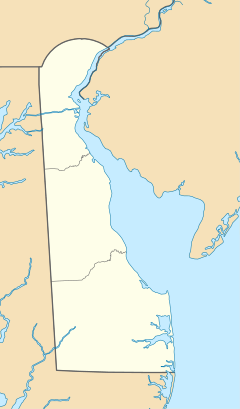Mispillion Light

Mispillion Light
|
|
|
Delaware
|
|
| Location | Mispillion River, Delaware |
|---|---|
| Coordinates | 38°56′51.0″N 75°18′54.5″W / 38.947500°N 75.315139°WCoordinates: 38°56′51.0″N 75°18′54.5″W / 38.947500°N 75.315139°W |
| Year first constructed | 1831 |
| Year first lit | 1873 |
| Deactivated | 1929 |
| Foundation | Natural |
| Construction | Wood Frame |
| Tower shape | Square |
| Height | 65 feet (20 m) |
| Original lens | Sixth order Fresnel lens |
| Current lens | Removed |
| Characteristic |
Flashing white every 3 seconds, flash duration 0.3 seconds, with a red sector from 301° to 308° |
|
Mispillion Lighthouse and Beacon Tower
|
|
| Nearest city | Milford, Delaware |
| Area | 0.5 acres (0.20 ha) |
| Built | 1873 |
| Architectural style | Gothic Revival, Carpenter Gothic |
| NRHP Reference # | 86002919 |
| Added to NRHP | February 18, 1987 |
| Heritage | place listed on the National Register of Historic Places |
|
[]
|
|
Flashing white every 3 seconds, flash duration 0.3 seconds, with a red sector from 301° to 308°
Mispillion Lighthouse is a lighthouse in Delaware, United States. It is on the Mispillion River near Delaware Bay.
The original Mispillion Lighthouse was built in 1831. The second Mispillion Lighthouse was a 65-foot (20 m) square cylindrical wood tower rising from one corner of a two-story Gothic style wood keeper's house and was built in 1873. It served until 1929, when it was deactivated and replaced by a steel skeleton tower that had originally served at Cape Henlopen. Over many years of private ownership and neglect, the lighthouse had fallen into an extreme state of disrepair, and was considered by Lighthouse Digest magazine to be "America's Most Endangered Lighthouse". After a fire started by lightning destroyed most of the tower portion of the lighthouse, the remains of the lighthouse were sold in 2002. A replica of the lighthouse was rebuilt at Shipcarpenter Square in Lewes, Delaware, in 2004 using what was left of the structure of the old lighthouse, and based on the original plans. The new owners also made a substantial addition during reconstruction, used as their living quarters. The steel skeletal tower remains at the original location but is not active or open to the public.
It was added to the National Register of Historic Places in 1987.
...
Wikipedia

